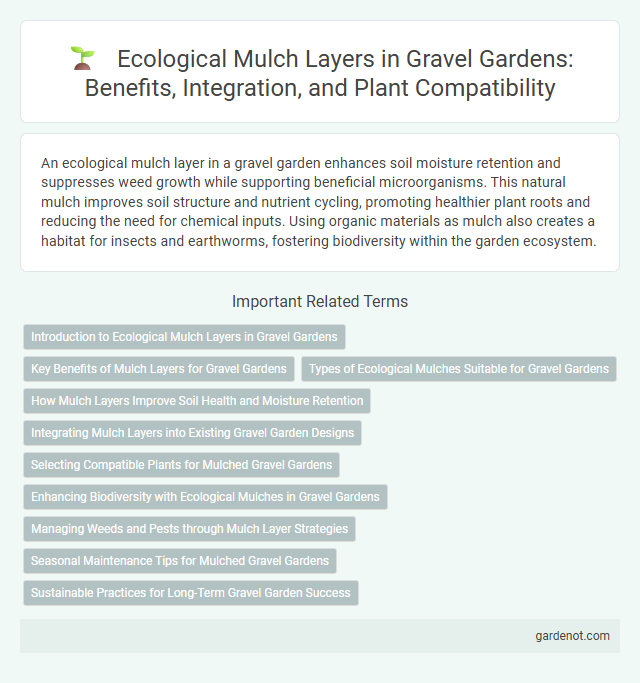An ecological mulch layer in a gravel garden enhances soil moisture retention and suppresses weed growth while supporting beneficial microorganisms. This natural mulch improves soil structure and nutrient cycling, promoting healthier plant roots and reducing the need for chemical inputs. Using organic materials as mulch also creates a habitat for insects and earthworms, fostering biodiversity within the garden ecosystem.
Introduction to Ecological Mulch Layers in Gravel Gardens
Ecological mulch layers in gravel gardens play a crucial role in promoting soil health by conserving moisture and suppressing weeds naturally. These layers consist of organic materials like leaf litter, compost, or bark chips that enhance microbial activity and nutrient cycling within the gravel substrate. Integrating ecological mulch supports sustainable gardening practices by maintaining a balanced ecosystem and improving plant resilience in gravel garden environments.
Key Benefits of Mulch Layers for Gravel Gardens
Mulch layers in gravel gardens enhance soil moisture retention by reducing evaporation, which supports healthier plant roots. They suppress weed growth, minimizing the need for herbicides and manual weeding, thus promoting a sustainable garden environment. Organic mulch also improves soil structure over time, enriching nutrient availability and fostering beneficial microbial activity essential for plant health.
Types of Ecological Mulches Suitable for Gravel Gardens
Types of ecological mulches suitable for gravel gardens include organic options such as bark chips, leaf mold, and composted wood, which improve soil structure and retain moisture without harming the environment. Inorganic mulches like crushed stone, gravel, and recycled glass complement the aesthetic of gravel gardens while suppressing weeds and reducing water evaporation. Choosing the right mulch depends on factors such as soil type, plant species, and local climate conditions to ensure a sustainable and thriving gravel garden ecosystem.
How Mulch Layers Improve Soil Health and Moisture Retention
Ecological mulch layers in gravel gardens enhance soil health by reducing erosion and supporting beneficial microbial activity through organic matter decomposition. These layers help maintain consistent soil moisture by minimizing evaporation and regulating temperature fluctuations, crucial for plant root stability. Applying mulch not only conserves water but also enriches nutrient cycling, promoting sustainable garden ecosystems.
Integrating Mulch Layers into Existing Gravel Garden Designs
Integrating an ecological mulch layer into existing gravel garden designs enhances soil moisture retention and promotes beneficial microbial activity without disrupting drainage. Applying organic mulch such as shredded bark or compost beneath the gravel layer supports plant health and suppresses weed growth while maintaining the garden's aesthetic appeal. This sustainable approach balances ecological benefits with the low-maintenance characteristics of gravel gardens.
Selecting Compatible Plants for Mulched Gravel Gardens
Choosing plants that thrive in well-drained, nutrient-poor conditions is essential for ecological mulch layers in mulched gravel gardens. Drought-tolerant species such as sedums, lavender, and ornamental grasses enhance soil stability while minimizing water use. Integrating native perennials supports local biodiversity and promotes a sustainable garden ecosystem.
Enhancing Biodiversity with Ecological Mulches in Gravel Gardens
Ecological mulches in gravel gardens create a nutrient-rich habitat that supports diverse microbial and insect populations, fostering a balanced ecosystem. This organic layer retains moisture and moderates soil temperature, promoting healthy root development for native plants adapted to gravel environments. By integrating ecological mulches, gardeners enhance biodiversity while reducing the need for chemical inputs and improving soil structure for long-term garden sustainability.
Managing Weeds and Pests through Mulch Layer Strategies
Ecological mulch layers in gravel gardens create a protective barrier that suppresses weed growth by blocking sunlight and reducing soil disturbance, promoting a healthier plant environment. Organic mulches also enhance soil moisture retention and foster beneficial microbial activity, which helps control pests naturally without chemical intervention. Selecting appropriate mulch materials, such as bark chips or leaf litter, supports biodiversity and strengthens the garden's resilience against invasive species and harmful insects.
Seasonal Maintenance Tips for Mulched Gravel Gardens
An ecological mulch layer in gravel gardens improves soil moisture retention and suppresses weeds by using organic materials like bark chips or compost. Seasonal maintenance includes replenishing mulch in spring to protect roots from temperature fluctuations and removing debris in autumn to prevent fungal growth. Regularly monitoring mulch depth ensures optimal soil health and supports beneficial insect habitats throughout the year.
Sustainable Practices for Long-Term Gravel Garden Success
An ecological mulch layer enhances soil moisture retention and suppresses weed growth, promoting sustainable practices for long-term gravel garden success. Organic materials like bark chips, leaf mold, or composted pine needles improve soil fertility and support beneficial microbial activity. Maintaining this mulch layer minimizes water usage and reduces the need for chemical interventions, ensuring an eco-friendly and resilient gravel garden ecosystem.
Ecological mulch layer Infographic

 gardenot.com
gardenot.com